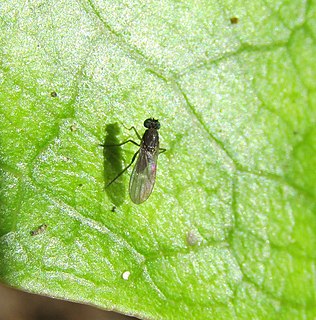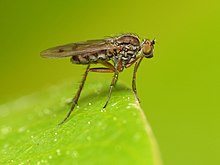Anasyntormon is a genus of flies in the family Dolichopodidae. It was originally placed in Rhaphiinae near Syntormon. It was moved to Dolichopodinae by Hans Ulrich (1980), who found it to be congeneric or closely related to Hercostomus.

Arachnomyia is a genus of flies in the family Dolichopodidae. It is known from Australia.

Asyndetus is a genus of flies in the family Dolichopodidae. There are more than 100 species described for the genus, distributed worldwide.

Chrysosoma is a genus of flies in the family Dolichopodidae. It is a large genus, with more than 200 species distributed in the Old World and Oceania.
Falbouria is a genus of flies in the family Dolichopodidae. It contains only one species, Falbouria acorensis, which is endemic to the Azores. The genus was originally named Balfouria by Octave Parent in 1933; it was renamed to Falbouria by C. E. Dyte in 1980, after the name Balfouria was found to be preoccupied by the snail genus Balfouria Crosse, 1884.
Ischiochaetus is a genus of flies in the family Dolichopodidae, found in New Zealand. The genus was originally named by Octave Parent in 1933. However, as the genus was not designated a type species, this name was unavailable until 1989, when Daniel J. Bickel and C. E. Dyte designated Ischiochaetus ornatipes as the type species.

Liancalus is a genus of flies in the family Dolichopodidae. It contains at least 21 species distributed worldwide except in Australasia and Oceania. The genus includes some of the largest species in the family, with body length approaching 12 mm in some species.
Liparomyia is a genus of fly in the family Dolichopodidae, known from Tasmania and the Australian Capital Territory.

Medetera is a large genus of flies in the family Dolichopodidae.

Micropygus is a genus of flies in the family Dolichopodidae, found in New Zealand. The genus was originally named by Octave Parent in 1933. However, as the genus was not designated a type species, this name was unavailable until 1989, when Daniel J. Bickel and C. E. Dyte designated Micropygus bifenestratus as the type species.
Nurteria is a genus of flies in the family Dolichopodidae, found in the Afrotropical realm. Three species are currently known in the genus, but there are also numerous undescribed species of the genus from southern Africa. It was originally described in the subfamily Diaphorinae, though it possesses some features of the Sympycninae.

Paraclius is a genus of flies in the family Dolichopodidae.
Peloropeodes is a genus of flies in the family Dolichopodidae.
Scelloides is a genus of flies in the family Dolichopodidae, found in New Zealand. The genus was originally named by Octave Parent in 1933. However, as the genus was not designated a type species, this name was unavailable until 1989, when Daniel J. Bickel and C. E. Dyte designated Scelloides ornatipes as the type species.

Hydrophorinae is a subfamily of flies in the family Dolichopodidae. Several studies have found evidence that the subfamily in its current sense is polyphyletic.

Diaphorinae is a subfamily of flies in the family Dolichopodidae.

Peloropeodinae is a subfamily of flies in the family Dolichopodidae. According to Germann et al. (2011), the subfamily is polyphyletic.

Sympycninae is a subfamily of flies in the family Dolichopodidae.











